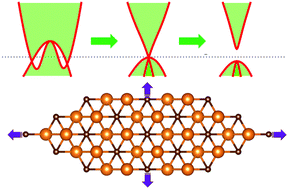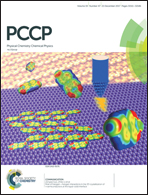Metal–semiconductor transition of two-dimensional Mg2C monolayer induced by biaxial tensile strain†
Abstract
Designing new two-dimensional (2D) materials with novel band topologies has continuously attracted intense interest in fundamental science and potential applications. Here, we report a unique 2D Mg2C monolayer featuring quasi-planar hexa-coordinate magnesium and hexa-coordinate carbon, which can be tuned from a metal to a semiconductor. The system has been studied using density functional theory, including electronic structure calculations and molecular dynamics simulations. In the freestanding state, the Mg2C monolayer behaves as a weak metal; however, by increasing the biaxial tensile strains, it can gradually be modulated to a gapless semimetal and then to a semiconductor. The Mg2C monolayer exhibits excellent dynamic and thermal stabilities and is also the global minimum of the 2D Mg2C system, implying the feasibility of its experimental synthesis. With unique band structures, the material may find applications in optoelectronics and electromechanics.



 Please wait while we load your content...
Please wait while we load your content...